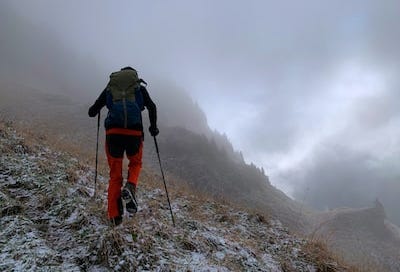Have Poles. Will Travel.
Trekking poles make light(er) work of steep uphills, mindfully breathe with a ball, a robust exercise program may prevent re-injuring your shoulder post-op, and your weekly recommendations
The Rundown
Have Poles. Will Travel. If you’re a trail runner or avid hiker attacking steep inclines this season, a new paper says you may want to grab trekking poles for those uphill pushes.
For the study, fifteen trail runners performed a series of tests with and without poles on both a specially constructed treadmill and a real mountain.
They wore portable VO2 analyzers to measure their aerobic efforts. The poles had a force transducer below the handgrip, which measured how hard they were pressing into the ground while insoles in their shoes recorded the force of their legs. The inclines were steep enough that the participants walked.
The findings on the treadmill were that the testers relied more on their poles as things got steeper and those who actively used their poles the hardest had the biggest force reduction in their legs. Similar results were found on the mountain. The participants’ insole-measured leg forces were around 5% lower with poles despite being 2.5% faster with poles.
The key takeaway: The poles did not save them energy. Rather, they helped the participants climb faster on steep uphills because they shifted some load from their legs to their arms.
Breath Ball. Alexz Farrall, a Ph.D. student at the University of Bath, has invented a ball that expands and contracts in time with a person’s inhalations and exhalations. Called PAWS (Physical Artifact for Well-Being Support), the goal of the soft, interactive ball is to give breath “physical form” in order to enhance self-awareness, engagement and “foster positive mental health outcomes.”
PAWS works through haptic feedback. Sensors attached to the user’s body transmit data about their respiration patterns to the ball via computer. The current prototype uses an electronic and pneumatic circuit to convert pulmonary activity to pneumatic activation. A future version will use Bluetooth and smart geometric structures to eliminate the need for wires.
Participants who used the ball along with a guided meditation app reported that it reduced their anxiety levels by an average of 75%. For comparison, people who used the app without the ball reported a 31% reduction in their anxiety levels. The results were presented earlier this year at the CHI Conference on Human Factors in Computing Systems.
A larger study is planned and Farrall hopes PAWS will be used in both clinical and home settings.
You can watch Alexz explain his invention here.
Sports Related Shoulder Injuries. Dislocating your shoulder in a forward direction, thanks to a direct blow, often happens while playing sport and if it does, you have a high risk of doing it again and suffering from recurrent instability.
According to new research published in the British Journal of Sports Medicine, starting a multimodal exercise program three to six weeks after surgery could prevent a repeat injury and get you back to sport faster.
In a three-year analysis of over 3,500 studies, the research team found that a program that targeted strength, coordination, balance and muscular control soon after surgery produced better results than programs that relied on strength training only.
Extra Point
Watch
Untold: Swamp Kings. This installment from the well-regarded Untold series tells the story of how coach Urban Meyer, using a military approach to training, turned the Florida Gators football team (circa 2000’s) into an almost unstoppable winning machine. It includes interviews with Meyer and members of the team, including Tim Tebow. Swamp Kings is streaming on Netflix.
Listen
Pursuing Health with Dr. Julie Foucher. In this podcast, host Julie Foucher, MD, MS and four-time CrossFit Games athlete wants to connect fitness and medicine to empower listeners. Weekly content comes out on Tuesdays and moves between interviews with experts, short reviews on health and fitness topics, and personal experiences of people who have “used lifestyle to overcome health challenges.”
Read
Good To Go. In this book, journalist and athlete Christie Aschwanden does a deep dive into rest and recovery research, with the goal of answering the question: What’s the right way to help your body recover from a workout?



